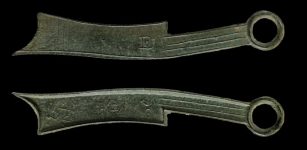Blackfoot People Carry DNA From Unknown Ancestors Who Came To America 18,000 Years Ago
Jan Bartek – MessageToEagle.com – A new interesting DNA study reveals that the Blackfoot people trace their ancestry to a previously unknown genetic lineage that dates back approximately 18,000 years when humans first inhabited the Americas.
Six Blackfeet Chiefs painted by Paul Kane along the North Saskatchewan River in Saskatchewan Canada. Credit: Public Domain
The research’s findings are significant for the Nations of the Blackfoot Confederacy, who have persistently strived to retain sovereignty over their territories and water resources. Both oral narratives and archaeological data suggest that the Blackfoot Indigenous communities and their ancestors resided across an extensive region of North America for a period exceeding 10,000 years.
The research published in Science Advances substantiates the connection. The genetic data confirm that modern Blackfoot people are closely related to those who lived on the land hundreds of years ago.
“Today, the Blackfoot Confederacy shoulders the U.S.-Canada border, comprising the Nations of Blackfeet, Kainai-Blood, Peigan-Piikani, and Siksika. Blackfoot people know that their ancestors, since time immemorial, have lived across the Rocky Mountains’s eastern slopes and adjacent plains of what is now Montana, Alberta, and Saskatchewan. Indigenous oral traditions and archaeological evidence indicate that more than 10,000 years ago these ancestors pursued bison along valleys and lakes carved by glaciers as the last ice age ended.
But U.S. and Canadian governments and energy sector interests have repeatedly threatened these ancestral lands or stripped them away since the 1800s. Blackfoot nations have taken legal actions to try to protect or win them back.
A recent success came in 2023 when, after years of litigation, gas and oil company Solenex LLC relinquished its federal lease to drill in the Badger-Two Medicine area of Montana. Yet in 2023, Canada’s Supreme Court heard a case arguing that the Kainai-Blood Tribe can only negotiate with, rather than sue, the federal government over land they were shortchanged in an 1877 treaty—despite a lower court ruling that the tribe is owed an additional 414 square kilometers,” the researchers write in their study published in Science Advances.
Credit: Adobe Stock – 2rogan
In the recent study, saliva samples were provided by six members of the current community. The research team also extracted DNA from the remains of four ancestors in collaboration with the Blackfeet Tribal Historic Preservation Office and three ancestors preserved at the Smithsonian Institution. Radiocarbon dating suggests that these historical remains will likely be between 100 and 200 years old.
Records from the museum indicate that these ancestral remains were acquired from Blackfoot territories, although precise details regarding their acquisition remain uncertain. It is a known tradition among Blackfoot people to place their deceased on trees or scaffolds prior to secondary burial. During periods of disease and famine in the 19th and 20th centuries, some bodies remained on scaffolds until they decayed and fell to ground level. There are records suggesting that scientists and other individuals may have removed these remains from burial sites, which could potentially explain how these ancestral artifacts ended up at the Smithsonian Institution.
In a comparative analysis of the genomes of contemporary and historical individuals, researchers discovered that they belong to a single lineage. This finding corroborates the oral traditions of the Blackfoot people, which assert their continuous presence in this region since time immemorial.
Subsequently, researchers attempted to determine when this particular lineage diverged from the primary known lineage leading to all other present-day Indigenous populations across North and South America that have been genetically studied. Their findings suggest that this divergence took place approximately 18,000 years ago. The discovery of this new lineage was quite unexpected, according to study co-author Ripan Malhi, a geneticist at UIUC who explained that the Blackfoot genomes did not statistically align with previously identified lineages in the Americas.
“The DNA study also provides the Blood Tribe/Kainai with a new line of evidence to help further treaty and aboriginal rights,” the study authors told Science in a collaborative statement.
Kim Tallbear, a University of Alberta professor of Native studies who was not involved with the research, cautions that incorporating genetics may not fundamentally alter the landscape of federal-tribal relationships.
See also: More Archaeology News
“We know Indigenous people were here before settlers. … It’s not a forgone conclusion that adding genetic information to what we already know about Indigenous history in the Americas is going to make a big difference,” Tallbear said.
The study was published in the journal Science Advances
Written by Jan Bartek – MessageToEagle.com – AncientPages.com Staff Writer













